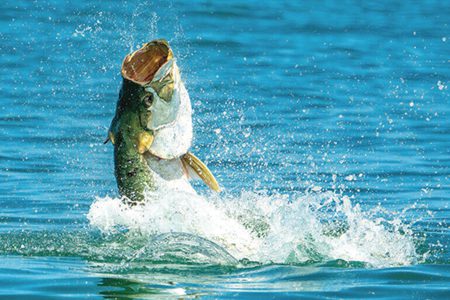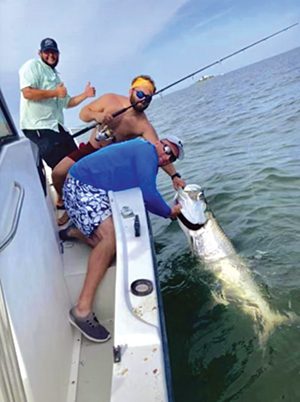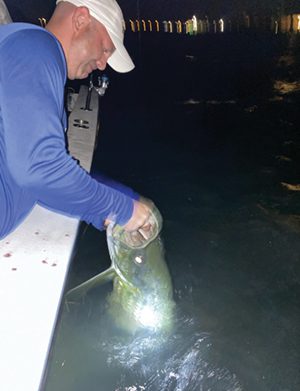
We have the pleasure of being able to catch tarpon year-round in the Florida Keys, however Spring tarpon is the best time of the year! Different seasons call for unique tarpon fishing techniques. For example, in the peak winter months when pilchards migrate into the flats, docks and bridges we mostly target domestic juvenile tarpon with razor bellied and sandy key pilchards. In the heat of the summer, we target domestic tarpon and a few migratory tarpon with pinfish with their tails cut off, cut bait and fish carcass’s. Stationary baits work best in the heat of the summer because the tarpon turn lethargic and are less likely to chase baits. They become more opportunist than anything. During the fall, we like to use small free lined shrimp under the dock lights at night and large free lined shrimp under the docks and bridges in the day light. The spring tarpon bite is the best because that’s when the big hungry spawning migratory tarpon show up. This annual migration typically starts in April and ends in July. I’ve seen it last as little as three weeks and as long as four months. A sure sign the tarpon migration is about to happen is when you start seeing the big schools of mullet showing up. Tarpon are weird acting prehistoric fish. Sometimes they will only feed on one kind of bait and that bait only. Sometimes they’ll feed on almost anything you cast at them. Marine Biologist say during several days during the tarpon migration they will only feed on pass crabs, because their bodies demand it during spawning to birth healthy offspring. Some of the best places to target tarpon during springtime are bridges. During the spring we target tarpon at three main bridges in the middle Keys.

The Bahia Honda Bridge: At Bahia Honda Bridge pass crabs and small blue crabs are the ticket. Sometimes we flat line them with a little piece and Styrofoam glued on the top of the crabs back and sometimes we free line the crab on a balloon or bobber. The speed of the current determines to technique and presentation. Funny thing is you can use mullet at Bahia Honda Bridge like you do at 7 Mile Bridge and never get a bite at Bahia Honda and vice versa you can use crabs at 7 Mile and never get a tarpon to look at it. They like certain baits at every bridge. A week or so out of the year during spring, the migratory tarpon gorge themselves on a little blackish/redish worm that hatches called the Palolo worm. When the Palolo worm hatches Bahia Honda Bridge is the best. If you are fortunate enough to be at Bahia Honda when the hatch happens, and you have proper Palolo worm lures or fly’s the bite can be phenomenal. They won’t feed on anything but the Palolo worm during the peak of the hatch.

In the recent past at the Long Key Bridge, you could experience a tarpon clubber a live mullet on top of the water, know you get less bites and the bites you do get are less exciting. Many experienced tarpon anglers and Local Captains look down on anglers how to chunk and chum for tarpon at Long Bridge.
— For a charter with Captain Joel or Jojo Brandenburg of Ana Banana Fishing Company in Marathon Florida Keys call cell 813-267-4401 or office 305-395-4212 or visit www.marathonkeyfishingcharters.com or visit us in person at Ana Banana Marina located at 11699 Overseas Hwy Marathon Florida Keys. Look for the big yellow Ana Banana sign with antlers around it.
